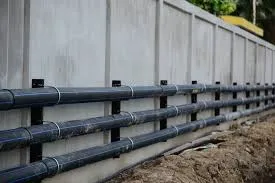Dec . 10, 2024 23:51 Back to list
High-Density Polyethylene Pipe Systems for Efficient Drip Irrigation Solutions
The Role of HDPE Pipe in Drip Irrigation Systems
Drip irrigation has emerged as one of the most efficient methods for delivering water to crops and plants while minimizing waste and ensuring optimal growth conditions. At the heart of many modern drip irrigation systems are High-Density Polyethylene (HDPE) pipes. Known for their durability, flexibility, and resistance to various environmental factors, HDPE pipes provide a superior solution for agricultural irrigation needs. This article explores the significance of HDPE pipes in drip irrigation systems, their benefits, and their impact on sustainable farming practices.
Understanding Drip Irrigation
Drip irrigation is a method that delivers water directly to the root zone of plants through a system of tubing, valves, and emitters. This technique allows for precise water application, reducing runoff and evaporation. By delivering water directly to the soil, drip irrigation enhances moisture retention, promotes better nutrient absorption, and leads to healthier crops. As water scarcity becomes a pressing global issue, the efficiency of drip irrigation makes it a preferred choice among farmers seeking sustainable practices.
The Advantages of HDPE Pipes
One of the standout features of HDPE pipes is their remarkable strength-to-density ratio. They can withstand high pressure, making them ideal for transporting water across varying terrains. Furthermore, HDPE is known for its resistance to weathering, chemicals, and ultraviolet (UV) degradation, ensuring a longer lifespan compared to traditional materials.
1. Durability and Longevity HDPE pipes can last for over 50 years, significantly reducing the need for replacements and maintenance. Their ability to resist corrosion and chemical reactions enhances their performance continuously.
2. Flexibility and Ease of Installation The flexibility of HDPE allows for easier installation in irregular landscapes, minimizing soil disturbance. This characteristic also helps in adapting to the dynamic environment of agricultural fields.
hdpe pipe drip irrigation

3. Cost-Effectiveness While the initial investment in HDPE pipes may be higher than other materials, their longevity and reduced maintenance costs make them a cost-effective option in the long run.
4. Leakage Reduction HDPE pipes come with welded joints that minimize the risk of leaks. This reduction in leakages increases the efficiency of water usage, which is crucial in regions where water is a limited resource.
5. Environmental Impact HDPE is 100% recyclable, making it a sustainable choice. By investing in HDPE pipes for drip irrigation, farmers can reduce their environmental footprint while promoting efficient water use in agriculture.
Impact on Agricultural Practices
The adoption of HDPE drip irrigation systems has transformed agricultural practices worldwide. With the ability to provide precise amounts of water directly to plants, farmers can optimize their water usage and reduce wastage. This optimization not only conserves water but also leads to higher crop yields and better quality produce. In regions facing drought or water scarcity, the use of HDPE in drip irrigation has proven particularly beneficial, allowing farmers to continue their operations sustainably.
In addition to improving crop productivity, HDPE drip irrigation systems contribute to healthier soil management. By minimizing surface runoff and erosion, these systems help maintain soil fertility and structure. Moreover, they enable farmers to implement nutrient-rich fertilization techniques without the risk of leaching into groundwater supplies.
Conclusion
High-Density Polyethylene pipes have revolutionized the way farmers approach irrigation. By leveraging the advantages of HDPE in drip irrigation systems, agricultural practices can become more sustainable, efficient, and productive. As we navigate the challenges of climate change and water scarcity, the integration of HDPE pipes in drip irrigation represents a crucial step towards a more resilient and sustainable agricultural future. By adopting these innovative solutions, farmers not only contribute to their own livelihoods but also to the sustainability of the environment and food security for generations to come.
-
High-Quality PPR Pipes and Fittings Durable ERA PPR & PVC PPR Solutions
NewsJul.08,2025
-
Black HDPE Cutting Board - Durable, Non-Porous & Food Safe HDPE Plastic Cutting Board
NewsJul.08,2025
-
High-Quality CPVC Panel Durable HDPE & PVC Panels Supplier
NewsJul.08,2025
-
Double PE Welding Rod Supplier - High Strength, Durable & Versatile Welding Solutions
NewsJul.07,2025
-
High-Quality PVC-O Pipe Supplier Durable 75mm PVC Pipe & Connections Leading PVC Pipe Company
NewsJul.07,2025
-
HDPE Drainage Pipe Supplier – Durable & Corrosion-Resistant Solutions
NewsJul.06,2025

